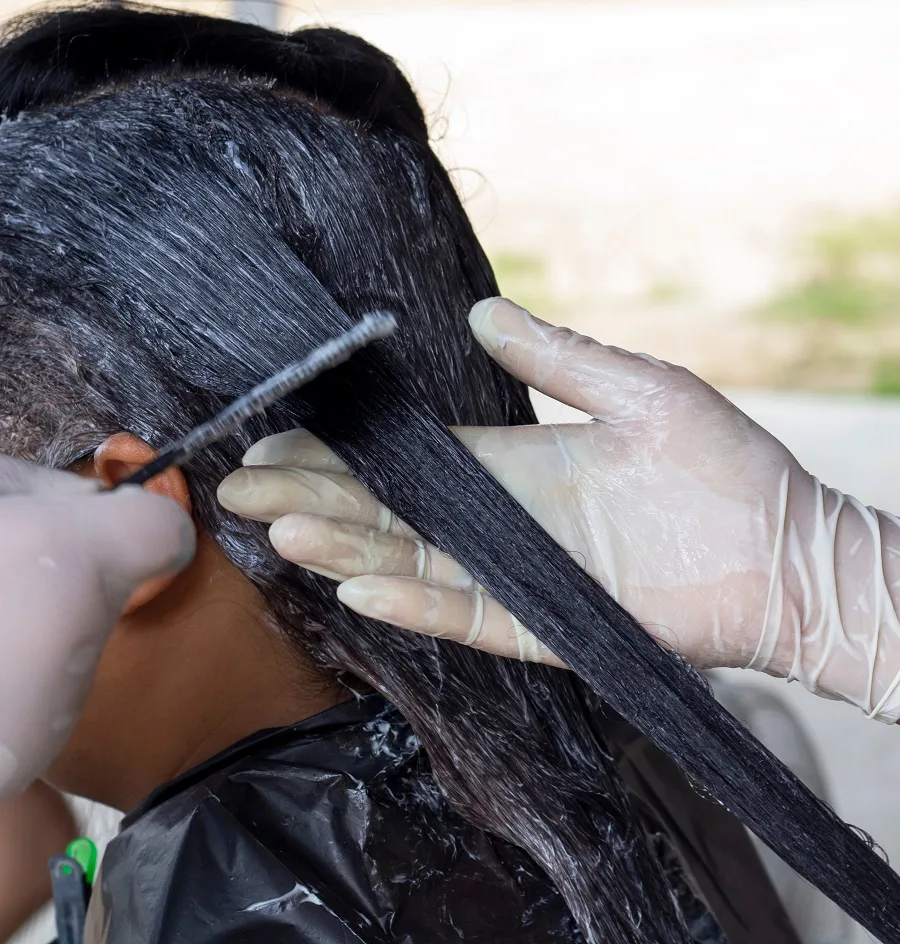Bleaching is part of styling life these days. But if you’re thinking of bleaching your relaxed hair, it’s natural to be concerned if it’s safe to do so. As both bleaching and relaxing are chemical processes, they’ll definitely cause stress to your hair. So, can you bleach your relaxed hair?
You’ll need to understand the risks, dos and don’ts while bleaching your relaxed hair. Else, you’ll end up damaging your hair.
Can I Bleach Relaxed Hair?
Can I Bleach My Relaxed Hair?
Yes, you can bleach your relaxed hair. However, it’s recommended not to bleach relaxed hair right after or within 24 hours of chemical straightening. This can cause your hair to lose its elasticity, making your hair porous and gummy.
Relaxing hair breaks down hair’s protein bonds, and adding bleach on top of that could cause split ends, dryness, and breakage.
But if you decide to bleach your relaxed hair, it’s essential to take extra precautions and be gentle with your locks.
Do’s and Dont’s While Bleaching Relaxed Hair

Relaxed hair refers to hair that has been chemically treated to be straighter and easier to manage. Bleaching relaxed hair can be tricky, so it’s best to be cautious to avoid damaging your locks. Here are some dos and don’ts to keep in mind when considering bleaching your relaxed hair:
Dos:
- Do a strand test before bleaching your scalp.
- Use a 20-volume developer or lower to avoid excessive damage.
- Start with small sections of hair and gradually work your way up to larger sections.
- Rinse out the bleach after 30 minutes, and don’t keep it longer than 45 minutes.
- Follow up with deep conditioning treatments every two weeks after bleaching to keep your hair healthy.
Don’ts:
- Avoid applying heat during or immediately after bleaching.
- Don’t leave the bleach on too long, as overprocessing can lead to breakage.
- Refrain from using higher volumes of developer than recommended to avoid damaging your relaxed hair.
- Avoid overlapping previously applied areas when applying bleach for even results.
- Never use at-home box dye kits, as these are often too strong for already chemically treated hair.
When Should You Bleach Relaxed Hair?
If you’re thinking about bleaching your relaxed hair, waiting at least a month after the last relaxer treatment is essential. This is because bleaching can be harsh on your hair, especially if it’s already been chemically treated.
Also, not all relaxers work well with bleach, so it’s best to consult a professional stylist before attempting chemical treatments.
How to Bleach Relaxed Hair Safely

Bleaching your relaxed hair with the proper techniques and products can safely help you achieve your desired look. Here are some helpful tips to guide you through the process:
- Choose a gentle bleach designed explicitly for use on relaxed hair.
- Do a patch test to ensure that the product won’t cause any damage to your scalp.
- Prepare your hair using deep conditioning treatments at least one week before starting the process.
- Follow the package instructions carefully when mixing up the bleach mixture.
- Apply the bleach mixture evenly and consistently throughout all sections of your hair.
- Don’t let the bleach sit in your hair longer than recommended.
- Rinse thoroughly until water runs clear to remove all traces of the bleach.
- Avoid heat-styling your hair for a few days after bleaching to give it time to recover.
- Take good care of your relaxed hair after bleaching by using gentle shampoos and conditioners, avoiding harsh chemicals, and moisturizing regularly.
How to Bleach Relaxed Hair Using Olaplex
Below we have discussed how you can bleach your relaxed hair with Olaplex without damaging your hair.
- Hair strand test: Before bleaching relaxed hair, it is recommended to do a hair strand test to check the condition of the hair. To do this, cut a few hair strands an inch in length and put them in a glass of water. If they sink to the bottom of the glass before five minutes, they have high porosity, which means they are still weak and may suffer damage from bleaching.
- Pre-bleach treatment: If the hair has high porosity and lower strength, a pre-bleach treatment with Olaplex no. 2 and a protein mask is recommended. To do this, mix 15 ml of Olaplex no. 2 with a protein mask and apply it to the relaxed hair a day before bleaching. This reduces hair porosity and builds strength, making it more resistant to damage during the bleaching process.
- Bleach: It is important to opt for a gentle bleach with a mild 20-volume developer, especially if the hair has recently been chemically relaxed. Drastically changing the hair color using bleach can cause severe hair damage. A 1-2 levels color lift is recommended for a gentle and less damaging process.
To reduce hair damage and protect the weaker bonds during the bleaching process, mix Olaplex no. 1 with bleach. Olaplex no. 1 is called the bond multiplier. It increases the number of disulfide bonds in the hair shaft. Mix 3 ml of bond multiplier with the bleach mixture. This will help repair broken bonds and prevent further damage. - Rinse hair: After rinsing the bleach away with water, apply Olaplex no. 2 to the hair and let it sit for 10-15 minutes to help further repair and strengthen the hair.
- Shampoo and Condition: Then, wash the hair with a gentle shampoo and condition it with a conditioner of your choice to keep it healthy and moisturized.
So, there you have it! The answer to ‘can you bleach relaxed hair’ is yes, but it should be done cautiously.
Using the right products and taking extra care when caring for your hair after -bleaching is essential. And most importantly, remember to prioritize the health of your hair.
Related Topics
